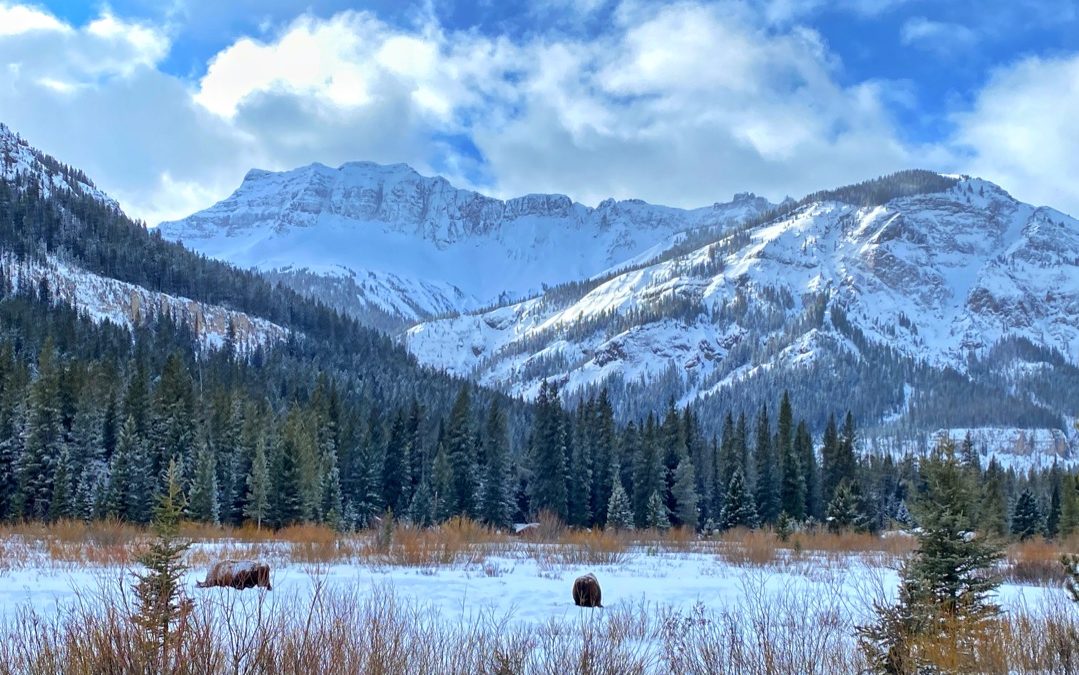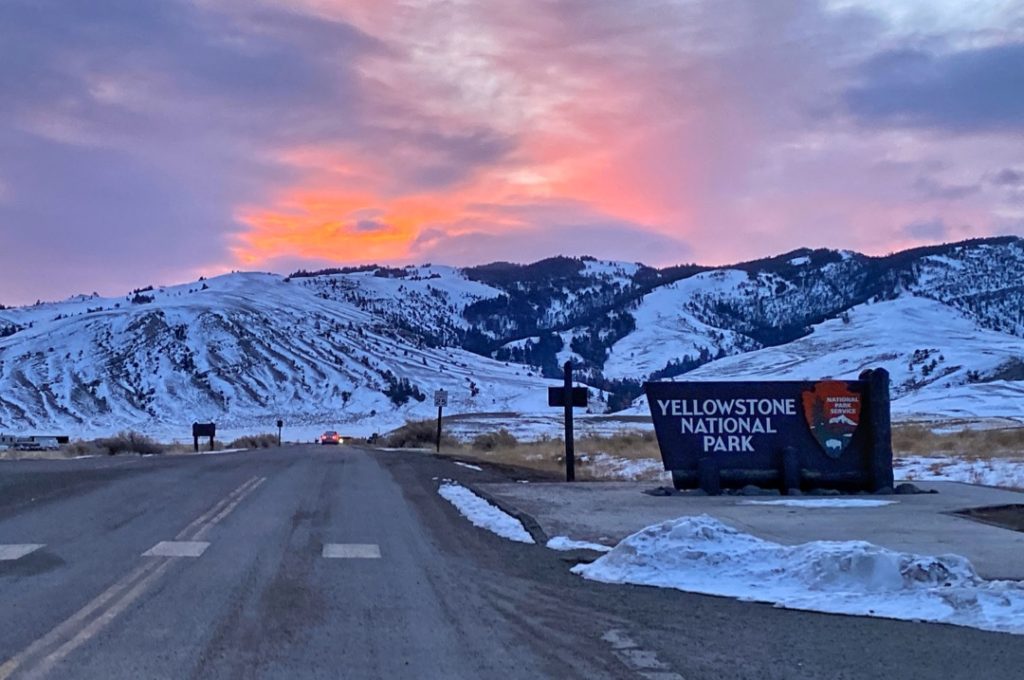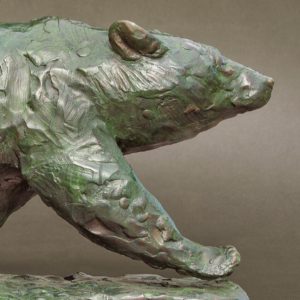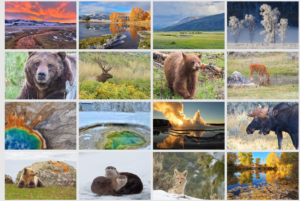From my comfy spot on the couch, I am staring up at towering spruce and fir trees and watching the snow fall. I have a floor to ceiling view of the forest, the thick tree trunks pillowed in deep, unbroken snow. The trickle of water remaining unfrozen in Soda Butte Creek sings softy by. I’m alone, in the silence, in this house perched in the woods. Away from crowds, photographers, snowmobiles, traffic, anyone! It’s immensely quiet and peaceful.
I’m here at Creekside at Yellowstone vacation rental in Silver Gate for a wildlife watching, photography, and cross country ski weekend. The owners Jill and Greg Warren graciously offered me the chance to stay here and talk about why I love Silver Gate and the northeast part of the park so much.
My love affair with the wild country near Yellowstone’s northeast entrance started in 1997 when I worked on a coyote research project out of Cooke City. It was my first trip to Yellowstone and Montana, and for an eastern girl, this place checked all the boxes: deep forests, imposing craggy peaks, wild animals, and endless places to hike and explore.
And that’s what I did that summer – hiking all the trails on the adjacent national forest I could find, and watching wildlife and sunsets in Lamar valley. I fell in love.
I brought George out with me in 2002; we celebrated our 1st wedding anniversary overlooking Yellowstone Lake and eating the stale top of our wedding cake that we’d schlepped all the way from Virginia in a cooler. We’ve been here ever since, on an almost 20 year journey together, in this ecosystem. We’ve lived at the Lamar Buffalo Ranch, and several places in Gardiner, both places we love and call home. But northeast Yellowstone is my first love.
So I jumped at the chance to come out for three days and talk about what it’s like to explore this corner of the park.
The sun was rising over the north entrance and Mt. Everts as I left Gardiner. I hadn’t gone very far before I encountered a bald eagle along the Gardner River. Relishing the fact that I had the entire day to myself, I pulled over and took my time observing the eagle. One of the joys of Yellowstone is the ability to slow down and fully experience each encounter. Yellowstone demands that you be present, that you pay attention – whether it’s to watch a coyote mousing in the sage, to brake for a herd of bison crossing the road, or to marvel at the brilliant colors and deadly waters of a thermal feature. It’s hard to have an agenda, here. Along the river, eventually another eagle came along, and the two flew off together, in lazy circles over the valley below.
The next stop on my meander was to watch three bull elk along Lava Creek, intent on foraging. One took several moments to rub his antlers on the low hanging boughs of a fir tree.
Rounding the corner to the Soda Butte valley, a ranger vehicle directs traffic to allow two moose to cross the road.
Stopping to scan in Round Prairie, I spotted a cow moose, browsing on willows. She kept looking east towards the forest, and eventually ran off. Was there something else in the woods? Another moose? A coyote or wolf? The only other sign I see is a magpie that flies over the creek and lands out of sight, although no other birds emerge from the area.
It’s a typical morning wildlife watching on the northern range.




Eventually I made my way on to Silver Gate, and checked in to the cabin.
After lunch, some writing, and a nap, I explored the trail to Silver Falls, which starts right across from the cabin. I took my Hok skis—though most people snowshoe, as it’s hilly with some downed logs—and had a gentle ramble through the woods. I didn’t see another soul, although the recent tracks indicated someone else had been through recently.
Silver Gate and Cooke City
As you leave the broad open valleys of the Lamar River and Soda Butte creek, the road begins to wind through austere and imposing peaks—Baronette, Abiathar, Thunderer—as it climbs to the northeast entrance and the tiny communities of Silver Gate and Cooke City, where the road ends in winter, and where you can continue on to access the Beartooth Highway in summer. Whereas Cooke City is the charismatic winter epicenter for extreme snowmobiling, Silver Gate is the quieter cousin, more inclined to curl up by the fire with a good book; both provide a great base for winter wildlife watching and skiing. Some folks more into quiet recreation tend to avoid Cooke City, but if you don’t mind the boisterous snowmobile scene, it’s still a convenient jumping off point to many great ski trails in the park and national forest wilderness (where snowmobilies are not allowed), as well as to the abundant wildlife watching of the northern range. And wildlife abounds in these two places; bison somehow find forage beneath the deep snow in winter, and moose are commonly seen along the Soda Butte, and grizzlies roam the trails in spring, summer, and fall.
Skiing Yellowstone’s Northeast Corner
After the first night, five friends joined me at the cabin for skiing. It was easy to convince them to come – there is always deep, reliable snow for skiing at this elevation where other trails might be more iffy, and the ability to ski at this end of the park without having to dodge bison all the way home is quite appealing. We made sure to ski the Bannock Trail, which runs from just inside the park’s northeast entrance 2 miles to to Silver Gate (just a short ski from the cabin). It’s a mellow, 4-5 mile round-trip ski that features breathtaking views of the surrounding peaks.
Another great ski near the northeast entrance is the Baronnette Trail, a 3.5 mile one-way ski in the spruce-fur forest beneath Baronnette Peak.
For more adventurous backcountry skiers, the area outside Cooke City and Silver Gate is filled with quiet and pristine wilderness to explore for a variety of skill levels. The local experts in this terrain are the great folks at Yellowstone Ski Tours and Beartooth Powder Guides.



Our recommendations for exploring Yellowstone’s Northeast Entrance in the off season
We recommend booking a vacation rental or a hotel that includes a kitchen or kitchenette. While there are a handful of restaurants open in the winter and shoulder seasons, it’s best to cook for yourself most meals and call ahead to local restaurants to make sure they will be open. Stop at the Gardiner Market on your way through Yellowstone’s north entrance, a great local market with a suprisingly diverse selection. It’s fun to check out the local ambiance in Cooke City, so do get out for dinner or breakfast on the town if you have a chance.
We feel it’s best to spend the mornings wildlife watching, and the afternoons skiing or snowshoeing. Wildlife is more active in the mornings, and the weather tends to be warmer as the day goes on, making a nice rhythm to the days.
For more information about Silver Gate and Cooke City, including restaurants and things to do, make sure to check out the Cooke City Chamber of Commerce. The Gardiner Chamber also has great blog posts on how to explore the area, and they both share the Yellowstone’s Northern Range website with more information on enjoying all the area has to offer.
Photos © Jenny Golding




